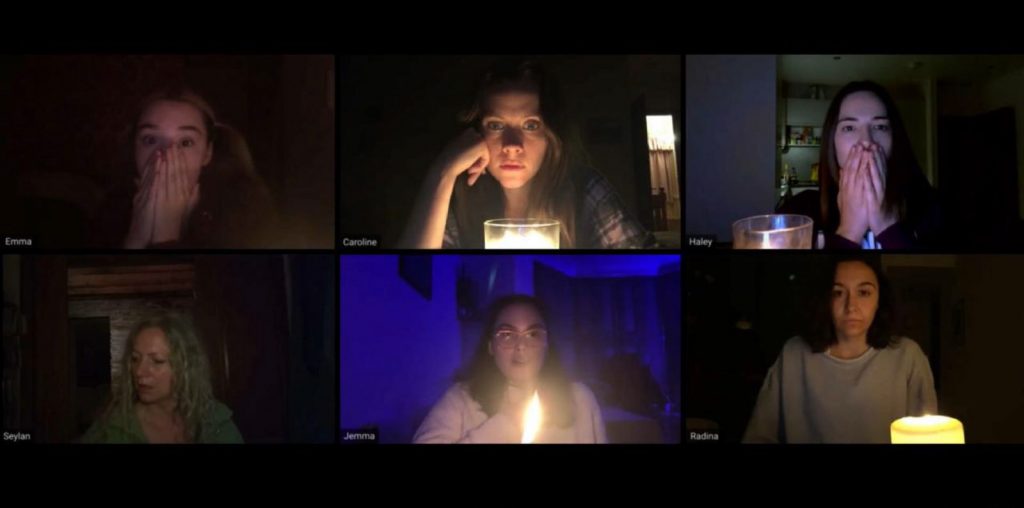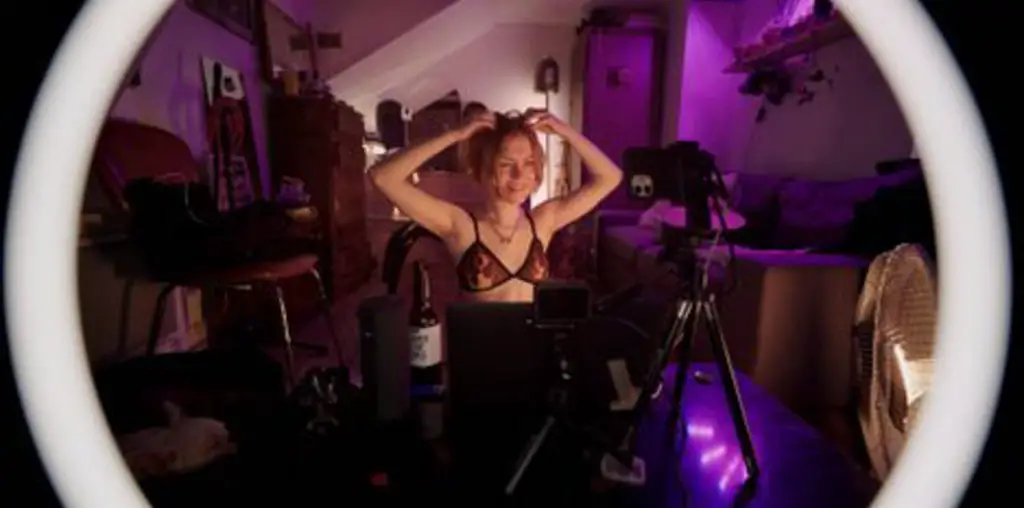
“Urban Visions” is a new collection of short films and videos by young, independent artists, which is available on-line and from a few retail stores. It is the first release from a company called lowave. What a laudable idea! We no longer live in an era in which shorts regularly precede feature films in theaters, and so shorts are mainly seen fleetingly in festivals. DVD is a natural format for distributing the work of independent artists who take short film seriously as an art form, and making it available to a wide and appreciative audience.
Curator Silke Schmikl attempts to frame this collection as a series of interrelated shorts on the theme of “urban experience,” a claim which is not at all convincing, since the films in fact are not all set in cities, and they certainly do not mutually illuminate each other on the putative theme. I’m not sure why the Marketing Gods have decreed that all collections of shorts need to have a concept tying them together. I would have been much happier if she had simply called the DVD “11 films which I think are really great and which go nicely together,” and left it at that.
About a third of the menu navigation buttons did not function properly on my Apple DVD player. The subtitles, in English, French, Spanish, German, Italian, and Japanese, would be a welcome addition to this international collection, but they also did not always function properly, and were absent from the filmmakers’ commentary section. The enclosed booklet also contained at least one typo. I hope that such sloppiness of production details does not become a feature of future lowave releases.
The collection is uneven, as is almost always the case with collections of shorts, and contains some truly bad films, such as “Push” by Gorka Aguado, a sequence of shots of electronic switches and buttons, set to a rhythmic score created from the sounds which the buttons generate, which is a rhythmic study with a leaden, lifeless sense of rhythm and badly realized digital “shatter” effects. Also at the bottom of the list is “Der Letzte Flug” by Silvana and Gerd Lombardi, a story of young heroin addicts which tries and utterly fails to be mordently hip and amusing.
However, the disc is dominated by high quality experimental films. Among the stand-outs is “Fausse Solitude” by Pierre-Yves Cruaud. The video image centers on the filmmaker himself, who remains steadily in the middle of the frame as the background cityscapes whirl in faster and faster circles, barely recognizable. The pace of this circular motion is quite fast at the beginning of the film, making it is difficult to distinguish individual features of the 360 degree panorama behind Cruaud, but allowing one to get an overall sense of the colors and textures of that particular setting. The pace continues to get faster and faster, so that soon no individual features whatsoever are discernible, only an overwhelming and disturbing feeling of motion going nowhere. The film functions by having one visual feature which remains relatively stable as the rest of the frame erupts into greater and greater chaos. As the stable feature, Cruaud’s face is an interesting thing to watch, since he looks like a French Elvis Costello (but more handsome.) He maintains an expression of utterly focused calm throughout, even as his hair tosses about with the motion, and his glasses reflect the rapidly changing light caused by the whirling. “Fausse Solitude” exhilaratingly transforms a city into a whirlwind.
“Raus Aus Seinen Kleidern,” written, directed by, and starring Corinna Schnitt, is a kind of reverse homage to Michael Snow’s masterpiece “Wavelength.” The film starts with an image of Schnitt on a penthouse balcony, repetitively shaking a red skirt against the guardrail, an action she continues throughout the seven and a half minute film. The soundtrack consists of a comically banal monologue by a woman who is obsessed with the care and maintenance of her clothes. She recounts her various relationships with men, who never seem to interest her as much as her laundry. Her endless chatter is hilarious, as one tries to imagine this pedantic and obsessive person actually having a relationship with another human being. The camera zooms out from her so slowly that one almost does not see it actually moving (but still much faster than the famous zoom in from “Wavelength.”) What is revealed, as our point of view pulls back, is that her balcony is in the middle of a dense urban landscape of high rise buildings of different styles, and her waving red skirt becomes a remote dot of color in the center. At the end of the film (forgive me for giving away the ‘plot’) we see that the whole scene is being viewed through a large picture window in another apartment, where another image of the same woman is sitting beside the window and delivering the monologue we are listening to. Schnitt has created that rare thing, a formalist, minimalist film which is also witty and engaging.
“Promenaux” is Stefano Canapa’s haunting 16mm black and white study of Paris. His film is an interesting blend of diaristic footage of the city, acted out scenes, and found footage. We see an older man walking the streets, and the passing phenomena which catch his eye: footfalls, shadows on walls, streetcars, a musician on a streetcar, the multicultural mélange of people in contemporary Paris. A middle section shows eerily pulsating light on different images from the nighttime city. A final section shows a girl reading a book of poems, boys practicing gymnastics next to a train yard, and the remarkably beautiful light of the city.
The blending of fiction and visual diary may seem to make this film hard to pin down, but the poetic and authoritative voice of Canapa’s camera and his editing make the film a unified and moving experience. His eye catches arresting and telling details of the urban landscape. His editing brings a free, loose, jazzy poetry to the material. The soundtrack, blending many sounds of the city with guitar music, is constructed with as much care and attention to detail as the images, and perfectly complements their blend of the real and the poetic.
Roger Beebe’s “The Strip Mall Trilogy” is not set in a city at all but in a Florida strip mall. How is an artist to respond to strip malls, those soul-deadening blights which seem to have destroyed 90% of the American landscape? Beebe responds by taking his Super 8 camera and aggressively, even desperately creating beauty from the ugliness. In Part One, he creates a rapid fire barrage of images, each lasting only a frame or two, of license plates, signs, car doors, speed bumps, etc. He uses sheer speed to try and blast out of the stifling commercialism of the mall and create a sense of liberation. It is accompanied by a loop made of sound samples from the mall, and the film is what Aguado’s “Push” should have been: a transformation of everyday commercial images, made by an artist with a strong visual and musical sensibility.
Part Two attempts to rebel against the coercive ubiquitousness of signage in the mall by breaking the signs down into their individual letters. Beebe goes through the entire alphabet repeatedly, sometimes rapidly and sometimes leisurely, using his camera to dehypnotize himself from the commercial mantras and rediscover color and form. The music, a child’s rendition of “The Alphabet Song” accompanied by an electric guitar, is a liberating and enjoyable counterpart to the images.
In Part Three Beebe enters a Zen state, and is able, with serene calmness, to create a beautiful sequence of abstract color and form out of sights from the mall; grates, parking spaces, bricks, advertisements, and fire hydrants. He has actually managed to bust apart the mind-controlling code of relentlessly commercial space and reconfigure it into a landscape of beautiful colors and forms. It is a remarkable piece of Super 8 alchemy.
In general, I found that the experimental films on the DVD are all stronger than the narratives. (This is not just a reflection of my taste for experimental film; I also love narrative film when it is original and well-executed.) I’m not sure if Schmickl included the narrative films because she truly likes and believes in them and in the mixture (in which case her taste is a bit different from mine), or if she simply believed that including some more conventional films would make the DVD more palatable to mainstream consumers. In any case, given her talent for finding experimental films which are entertaining, engrossing, and emotionally engaging, she could easily assemble collections which consist exclusively of experimental work and still expect them to sell well. I look forward to more of her collections in the future.

